Discriminant Analysis of the Vibrational Behavior of a Gas Micro-Turbine as a Function of Fuel †
Abstract
1. Introduction
2. Materials
- Calibration of the accelerometer;
- Implementation of the accelerometer to the brackets and anchoring them to the injector;
- Preparation of fuel mixtures with additives using a graduated cylinder;
- Starting the turbine with the design fuel (kerosene) and the required power of 10 kW;
- Waiting for the turbine operating conditions by checking that the exhaust gas temperature is 590 °C as declared by the name plate;
- Adjustment of turbine power (approx. 19 kW) to reach the preset speed of 85,000 rpm;
- Accelerometer acquisition for kerosene supply;
- Adjustment of power output to 10 kW;
- Gradual switchover from kerosene fueling to pure diesel;
- Adjustment of turbine power (approx. 19 kW) to reach the preset speed of 85,000 rpm;
- Accelerometer acquisition for pure diesel fuel supply;
- Adjustment of power output to 10 kW;
- Gradual switchover from pure diesel fuel to 1% rapeseed oil diesel;
- Adjustment of turbine power (approx. 19 kW) to reach the preset speed of 85,000 rpm;
- Accelerometer acquisition for feeding 3% rapeseed oil diesel;
- Adjustment of power output to 10 kW;
- Gradual switchover from 1% rapeseed oil to 3% rapeseed oil admixed fuel;
- Adjustment of turbine power (approx. 18.5 kW) to reach the preset speed of 85,000 rpm;
- Accelerometer acquisition for 3% rapeseed oil diesel;
- Adjustment of power output to 10 kW;
- Gradual switchover from 3% rapeseed oil diesel supply to pure kerosene;
- Turbine shutdown with design fuel (kerosene).
3. Methods
4. Results and Discussion
4.1. Variables Included in the Classification Model
4.2. Cluster Analysis
4.3. Classification Summary
5. Conclusions
- For the 75,000 rpm case, a strong distinction emerges between pure and admixed fuels: for the pure fuels, the quadratic oscillation index assumes the greatest values suggesting that the explosive power of the fuel is fully exploited while there is a decrease in the explosive power and pollutants for the admixed fuels. Non-normalized Shannon entropy show a no-stationary and no-periodic vibrational cycle, in particular for the admixed fuels;
- For the 80,000 rpm case, just as for the previous case, it is possible to well-distinguish pure and admixed fuels (by non-normalized Shannon entropy and RMS), but at the same time, thanks to the asymmetry, an excellent distinction emerges between the turbine design fuel (kerosene) and the others (diesel family);
- For the 85,000 rpm case, the distinction is evident of how dynamic energy is best exploited using kerosene (by RMS), and how vibrations tend to be more regular with pure fuels (by asymmetry).
- The 75,000 rpm case showed the distinction between the pure and admixed family: they are in two different zones of the diagram in Figure 7a. The admixed diesel with 1% rapeseed oil has a greater tendency toward pure diesel than the diesel with 3% rapeseed oil;
- The 80,000 rpm case provided the best possible differentiation among all the fuels because of the formation of four distinct, separate and non-overlapping clusters. In this diagram, it is possible to distinguish between the diesel and the kerosene family;
- As for the previous speed, the case at 85,000 rpm led to the distinction between the diesel and the kerosene family but not an optimal distinction between the two admixed fuels because of overlapping clusters.
- In the case at 75,000 rpm, the clusters with respect to function 2 were always very dispersed around their centroids, underlining how the turbine presents vibrational cycles that are not very stationary and not very periodic, while the clusters with respect to function 1 show that the dynamic power of the system is better exploited with pure fuels. The best performance is with the pure fuels, but the lower emissions and costs are with the admixed fuels.
- In the case at 80,000 rpm, the clusters with respect to function 1 are always grouped around their own centroids, highlighting more stationary and periodic vibrations than the other cases. This is the best working condition for the turbine.
- In the case of 85,000 rpm, referring to function 1, the kerosene has the highest values and better exploits dynamic energy, while the diesel family presents a similar range of values. Regarding function 2, there is a clear distinction between admixed and pure diesels: the pure diesel presents higher explosive power. Thus, kerosene has the best possible performance but is the most expensive. The three diesels are cheaper but make the turbine less efficient. Lastly, there is not a great difference between using an admixed diesel with 1 or 3% rapeseed oil.
Author Contributions
Funding
Data Availability Statement
Conflicts of Interest
References
- Rochelle, D.; Najafi, H. A review of the effect of biodiesel on gas turbine emissions and performance. Renew. Sustain. Energy Rev. 2019, 105, 129–137. [Google Scholar] [CrossRef]
- Bazooyar, B.; Darabkhani, H.G. Design, manufacture and test of a micro-turbine renewable energy combustor. Energy Convers. Manag. 2020, 213, 112782. [Google Scholar] [CrossRef]
- Ameli, S.M.; Agnew, B.; Potts, I. Integrated distributed energy evaluation software (IDEAS) Simulation of a micro-turbine based CHP system. Appl. Therm. Eng. 2007, 27, 2161–2165. [Google Scholar] [CrossRef]
- Karvountzis-Kontakiotis, A.; Andwari, A.M.; Pesyridis, A.; Russo, S.; Tuccillo, R.; Esfahanian, V. Application of Micro Gas Turbine in Range-Extended Electric Vehicles. Energy 2018, 147, 351–361. [Google Scholar] [CrossRef]
- Menkiel, B.; Donkerbroek, A.; Uitz, R.; Cracknell, R.; Ganippa, L. Combustion and soot processes of diesel and rapeseed methyl ester in an optical diesel engine. Fuel 2014, 118, 406–415. [Google Scholar] [CrossRef]
- Daho, T.; Vaitilingom, G.; Sanogo, O.; Ouiminga, S.K.; Zongo, A.S.; Pirioud, B.; Koulidiati, J. Combustion of vegetable oils under optimized conditions of atomization and granulometry in a modified fuel oil burner. Fuel 2014, 118, 329–334. [Google Scholar] [CrossRef]
- Bayındır, H.; Zerrakki Isık, M.; Argunhan, Z.; Lütfü Yücel, H.; Aydın, H. Combustion, performance and emissions of a diesel power generator fueled with biodiesel-kerosene and biodiesel-kerosene-diesel blends. Energy 2017, 123, 241–251. [Google Scholar] [CrossRef]
- Nascimento, M.A.; Lora, E.S.; Corrêa, P.S.; Andrade, R.V.; Rendon, M.A.; Venturini, O.J.; Ramirez, G.A. Biodiesel fuel in diesel micro-turbine engines: Modelling and experimental evaluation. Energy 2008, 33, 233–240. [Google Scholar] [CrossRef]
- Rakopoulos, D.C.; Rakopoulos, C.D.; Giakoumis, E.G. Impact of properties of vegetable oil, bio-diesel, ethanol and n-butanol on the combustion and emissions of turbocharged HDDI diesel engine operating under steady and transient conditions. Fuel 2015, 156, 1–19. [Google Scholar] [CrossRef]
- Chiaramonti, D.; Rizzo, A.M.; Spadi, A.; Prussi, M.; Riccio, G.; Martelli, F. Exhaust emissions from liquid fuel micro gas turbine fed with diesel oil, biodiesel and vegetable oil. Appl. Energy 2013, 101, 349–356. [Google Scholar] [CrossRef]
- Boomadevi, P.; Paulson, V.; Samlal, S.; Varatharajan, M.; Sekar, M.; Alsehli, M.; Tola, S. Impact of microalgae biofuel on microgas turbine aviation engine: A combustion and emission study. Fuel 2021, 302, 121–155. [Google Scholar] [CrossRef]
- Chiong, M.C.; Chong, C.T.; Ng, J.H.; Lam, S.S.; Tran, M.V.; Chong, W.W.F.; Valera-Medina, A. Liquid biofuels production and emissions performance in gas turbines: A review. Energy Convers. Manag. 2018, 173, 640–658. [Google Scholar] [CrossRef]
- Enagi, I.I.; Al-Attab, K.A.; Zainal, Z.A. Liquid biofuels utilization for gas turbines: A review. Renew. Sustain. Energy Rev. 2018, 90, 43–55. [Google Scholar] [CrossRef]
- Sallevelt, J.L.H.P.; Gudde, J.E.P.; Pozarlik, A.K.; Brem, G. The impact of spray quality on the combustion of a viscous biofuel in a micro gas turbine. Appl. Energy 2014, 132, 575–585. [Google Scholar] [CrossRef]
- Lv, X.; Liu, X.; Gu, C.; Weng, Y. Determination of safe operation zone for an intermediate temperature solid oxide fuel cell and gas turbine hybrid system. Energy 2016, 99, 91–102. [Google Scholar] [CrossRef]
- Reggio, F.; Ferrari, M.L.; Silvestri, P.; Massardo, A.F. Vibrational analysis for surge precursor definition in gas turbines. Meccanica 2019, 54, 1257–1278. [Google Scholar] [CrossRef]
- Kaczmarczyk, T.Z.; Żywica, G.; Ihnatowicz, E. Measurements and vibration analysis of a five-stage axial-flow microturbine operating in an ORC cycle. Diagnostyka 2017, 18, 51–58. [Google Scholar]
- Waumans, T.; Waumans, T.; Vleugels, P.; Peirs, J.; Al-Bender, F.; Reynaerts, D. Rotordynamic behaviour of a micro-turbine rotor on air bearings: Modelling techniques and experimental verification. In Proceedings of the International Conference on Noise and Vibration Engineering, Heverlee, Belgium, 18–20 September 2006. [Google Scholar]
- Talebi, S.S.; Tousi, A.M. The effects of compressor blade roughness on the steady state performance of micro-turbines. Appl. Therm. Eng. 2017, 115, 517–527. [Google Scholar] [CrossRef]
- Cafaro, S.; Traverso, A.; Ferrari, M.L.; Massardo, A.F. Performance Monitoring of Gas Turbine Components: A Real Case Study Using a Micro Gas Turbine Test Rig. In Proceedings of the ASME Turbo Expo, Genova, Italy, 8–12 June 2009. [Google Scholar]
- Rahmounea, M.B.; Hafaifaa, A.; Kouzoua, A.; Chenc, X.; Chaibetd, A. Gas turbine monitoring using neural network dynamic nonlinear autoregressive with external exogenous input modelling. Math. Comput. Simul. 2021, 179, 23–47. [Google Scholar] [CrossRef]
- Allouis, C.; Amoresano, A.; Capasso, R.; Langella, G.; Niola, V.; Quaremba, G. The impact of biofuel properties on emissions and performances of a micro gas turbine using combustion vibrations detection. Fuel Process. Technol. 2018, 179, 10–16. [Google Scholar] [CrossRef]
- Amoresano, A.; Avagliano, V.; Niola, V.; Quaremba, G. The assessment of the in-cylinder pressure by means of the morpho-dynamical vibration analysis—Methodology and application. Int. Rev. Mech. Eng. 2013, 7, 999–1006. [Google Scholar]
- Niola, V.; Quaremba, G.; Forcelli, A. The detection of gear noise computed by integrating the Fourier and Wavelet methods. WSEAS Trans. Signal Process. 2008, 4, 60–67. [Google Scholar]
- Niola, V.; Quaremba, G. The Gear Whine Noise: The influence of manufacturing process on vibro-acoustic emission of gear-box. In Proceedings of the 10th WSEAS International Conference, Recent Researches in Communications, Automation, Signal Processing, Nanotechnology, Astronomy and Nuclear Physics, Athens, Greece, 20 February 2011. [Google Scholar]
- Spirto, M.; Savino, S.; Quaremba, G.; Cosenza, C.; Nicolella, A.; Niola, V. Discriminant analysis of the vibrational dynamics of a gas microturbine with different fuels. In Proceedings of the 5th Jc-IFToMM International Symposium, the 28th Jc-IFToMM Symposium on Theory of Mechanism and Machines, Kyoto, Japan, 16 July 2022. [Google Scholar]
- Niola, V.; Quaremba, G. Sistemi Vibrazionali Complessi Teoria, Applicazioni e Metodologie Innovative di Analisi, 1st ed.; Nane Edizioni: Italy, 2015. [Google Scholar]
- Niola, V.; Spirto, M.; Savino, S.; Cosenza, C. Vibrational analysis to detect cavitation phenomena in a directional spool valve. Int. J. Mech. Control 2021, 22, 11–16. [Google Scholar]
- Cosenza, C.; Nicolella, A.; Genovese, A.; Niola, V.; Savino, S.; Spirto, M. A Vision Based Approach to Study Lubrication Conditions in Gearwheels. In Proceedings of the 4th International Conference of the IFToMM Italy, Naples, Italy, 7 September 2022. [Google Scholar]
- Niola, V.; Savino, S.; Quaremba, G.; Cosenza, C.; Spirto, M.; Nicolella, A. Study on the Dispersion of Lubricant Film from a Cylindrical Gearwheels with Helical Teeth by Vibrational Analysis. WSEAS Trans. Appl. Theor. Mech. 2021, 16, 274–282. [Google Scholar] [CrossRef]
- Warrens, M.J. Five Ways to Look at Cohen’s Kappa. J. Psychol. Psychother. 2015, 5, 1–4. [Google Scholar] [CrossRef]
- Sun, S. Meta-analysis of Cohen’s kappa. Health Serv. Outcomes Res. Methodol. 2011, 11, 145–163. [Google Scholar] [CrossRef]
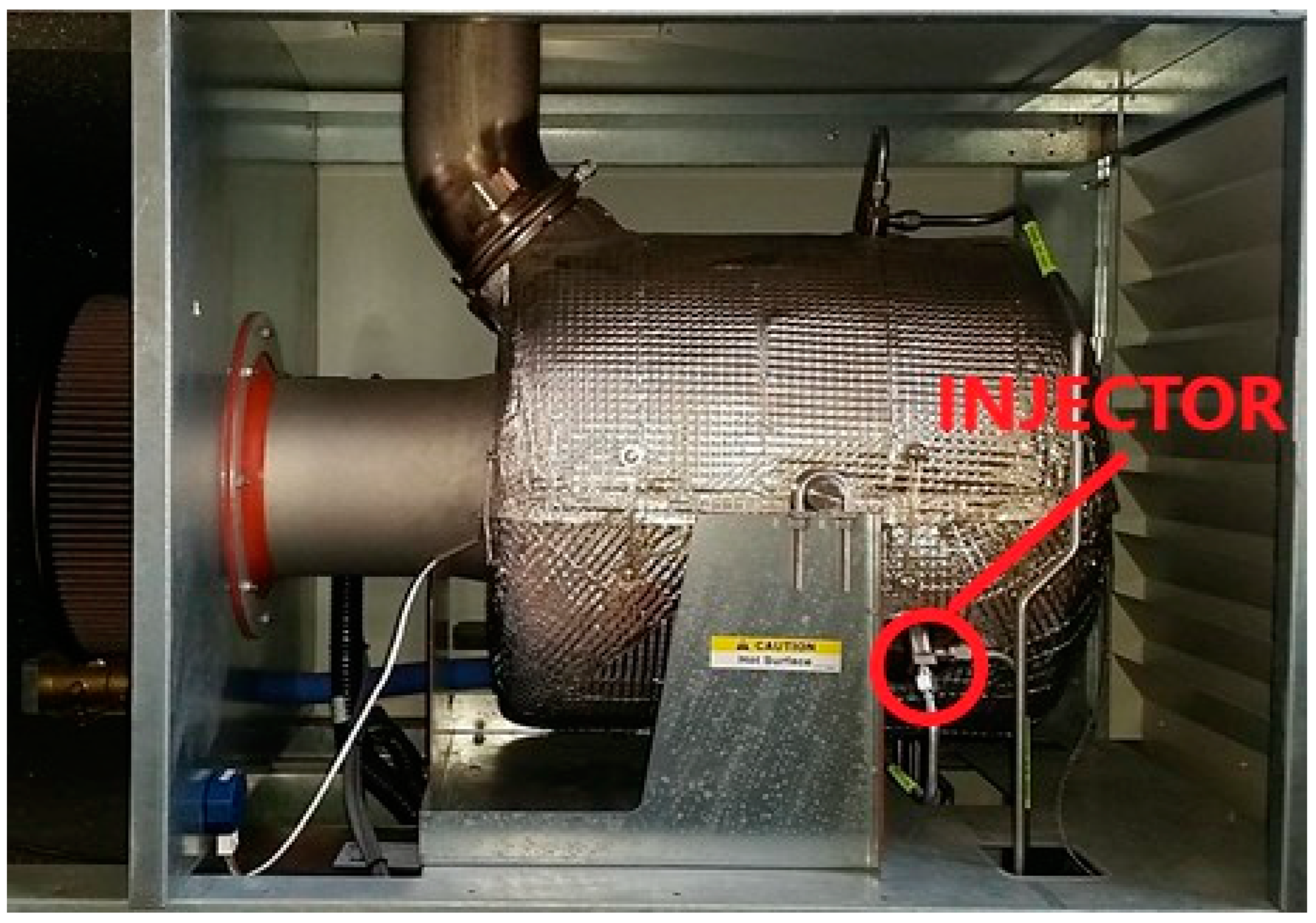
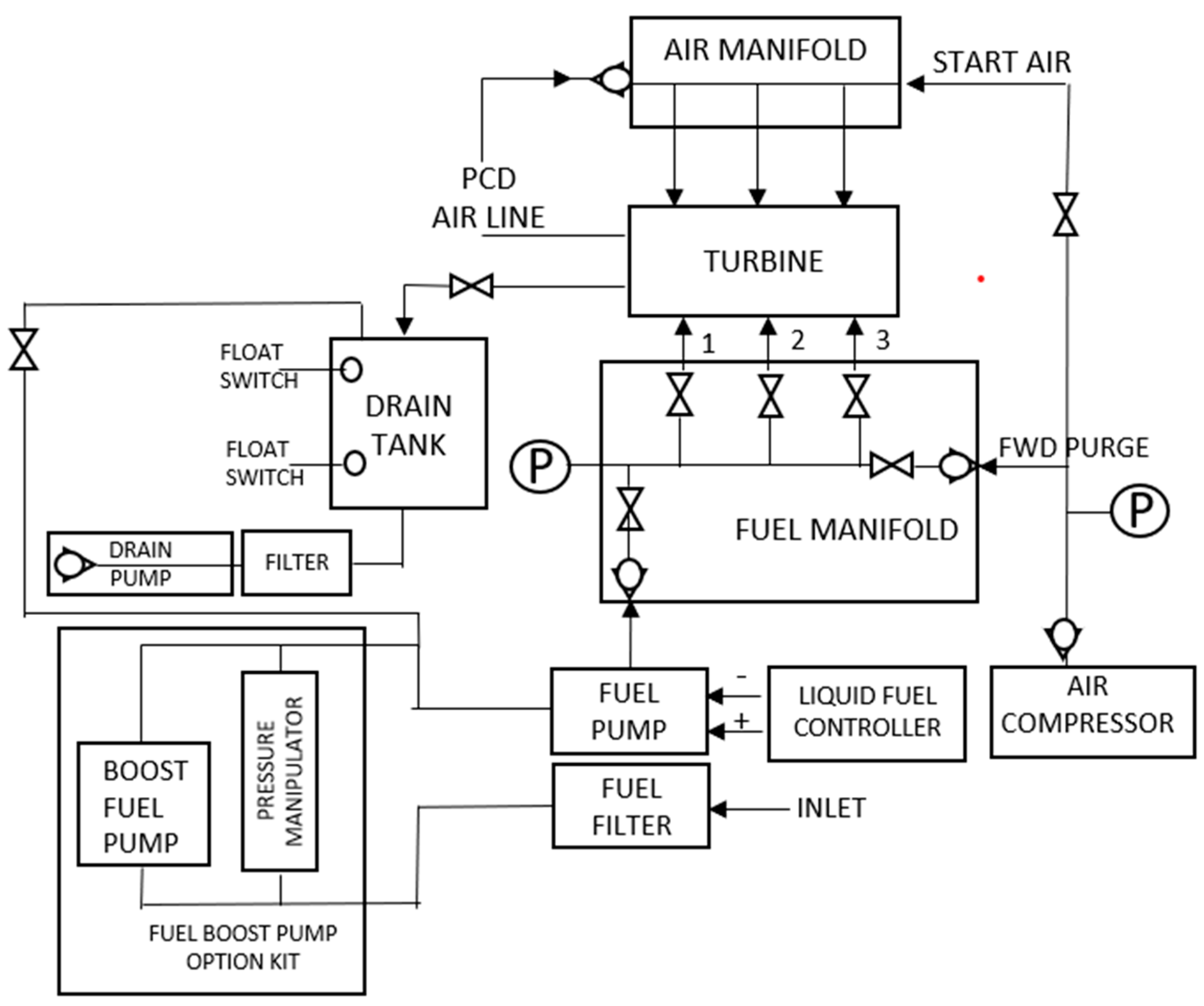
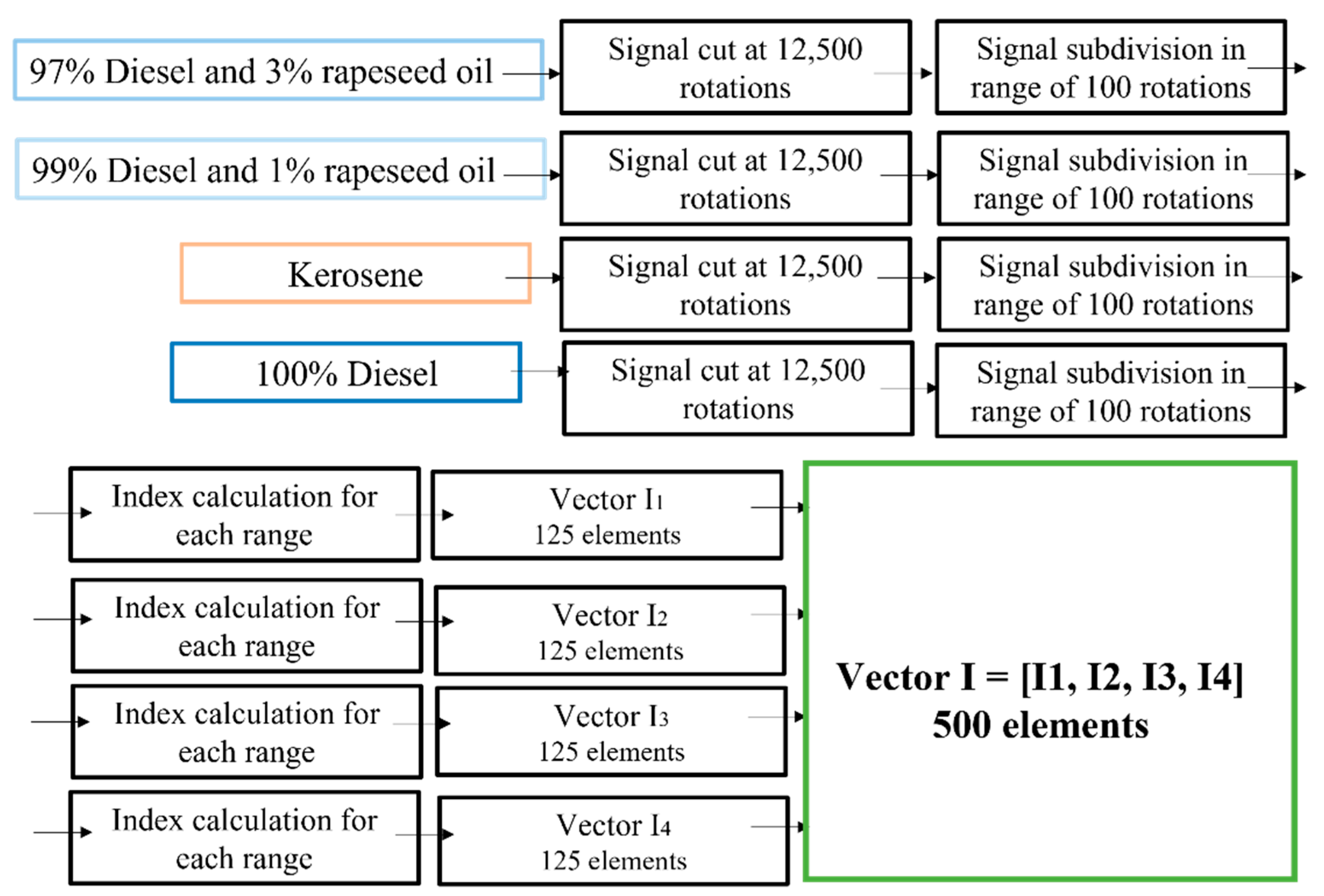
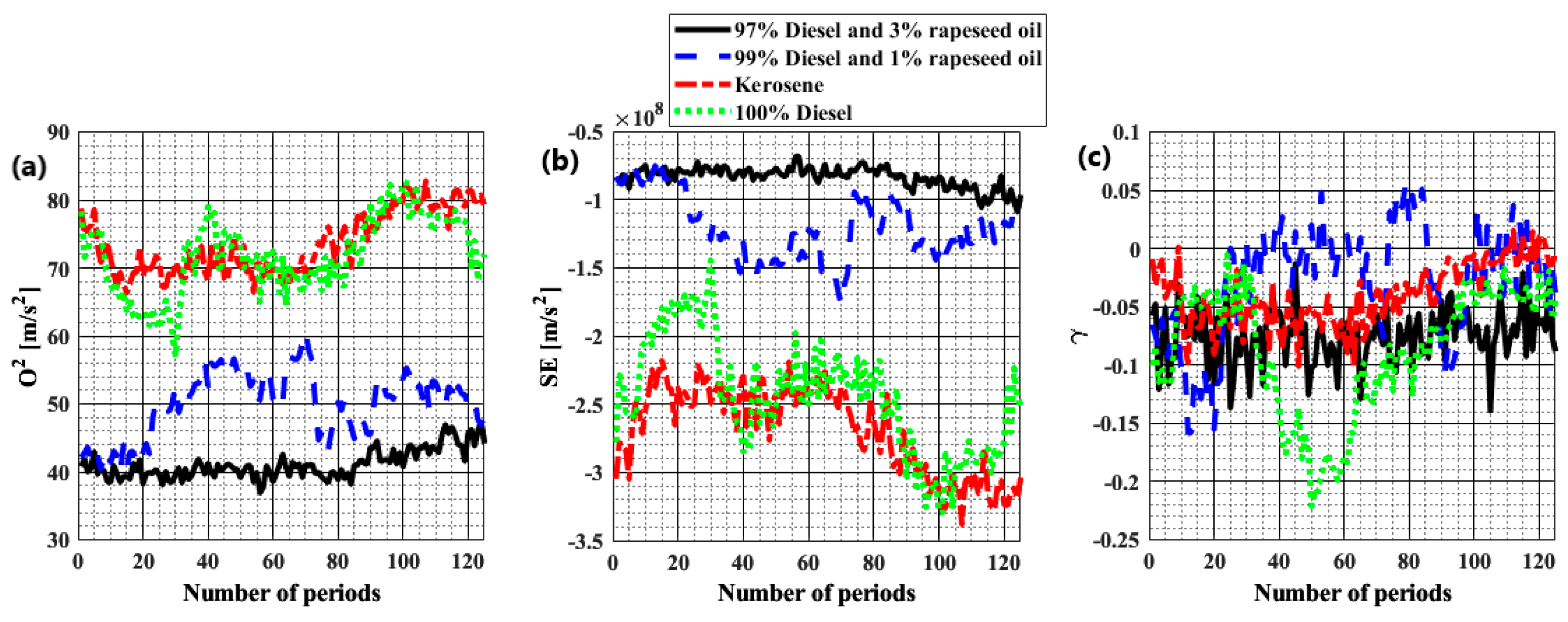

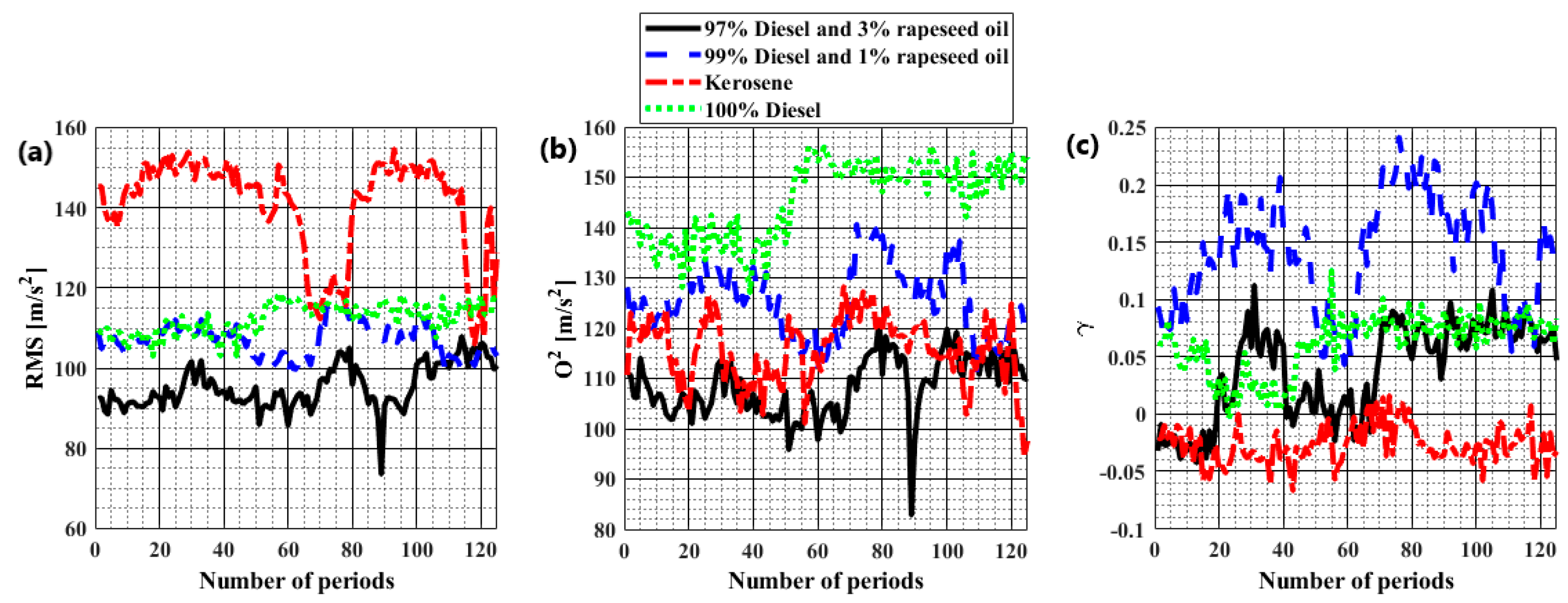

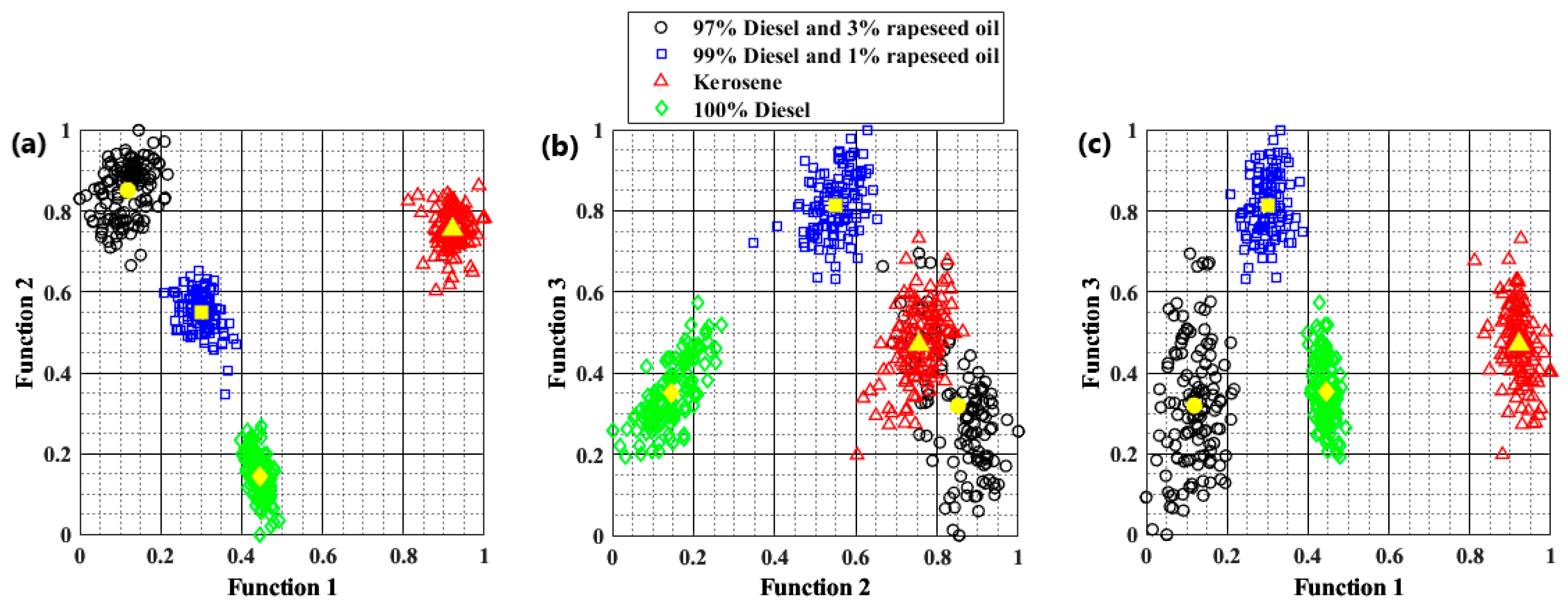
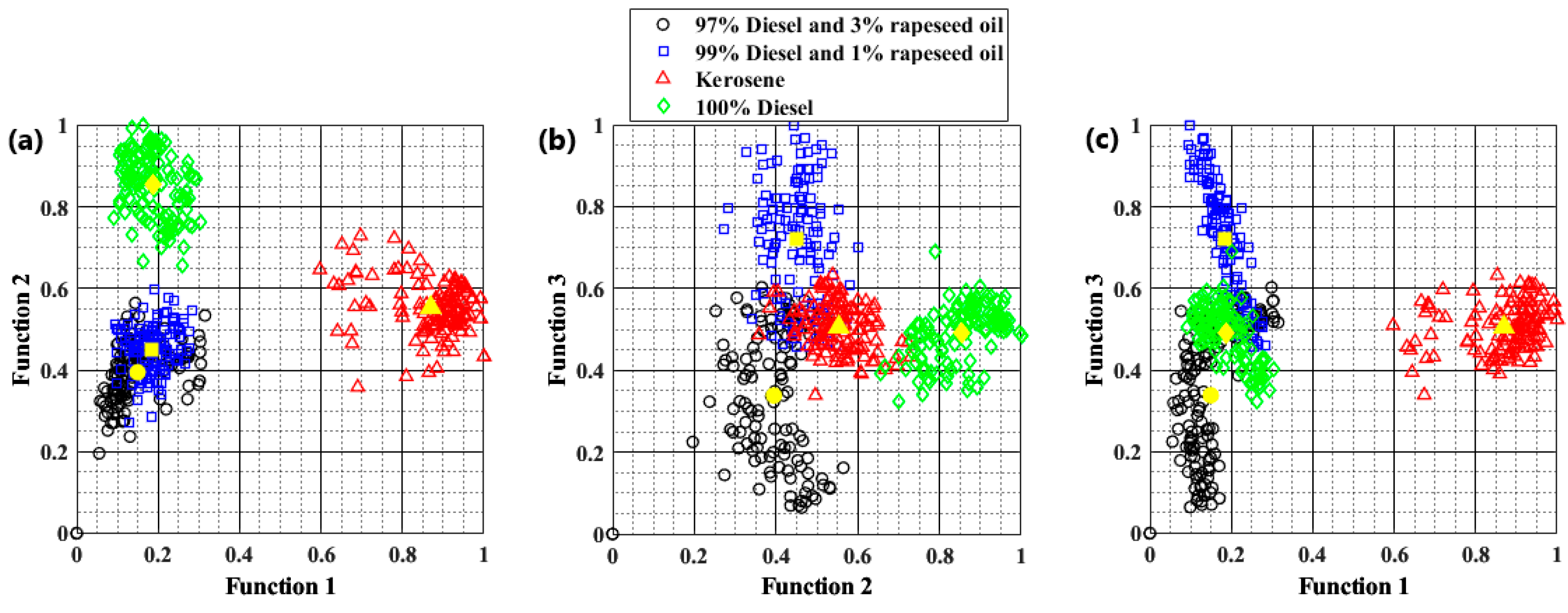
| Test Number | Fuel | RPM |
|---|---|---|
| 1 | 97% Diesel and 3% rapeseed oil | 75,000 |
| 2 | 99% Diesel and 1% rapeseed oil | 75,000 |
| 3 | Kerosene | 75,000 |
| 4 | 100% Diesel | 75,000 |
| 5 | 97% Diesel and 3% rapeseed oil | 80,000 |
| 6 | 99% Diesel and 1% rapeseed oil | 80,000 |
| 7 | Kerosene | 80,000 |
| 8 | 100% Diesel | 80,000 |
| 9 | 97% Diesel and 3% rapeseed oil | 85,000 |
| 10 | 99% Diesel and 1% rapeseed oil | 85,000 |
| 11 | Kerosene | 85,000 |
| 12 | 100% Diesel | 85,000 |
| Step | 75,000 rpm | 80,000 rpm | 85,000 rpm |
|---|---|---|---|
| 1 | Quadratic Oscillation Index () | Non-Normalized Shannon Entropy () | Root Mean Square Value () |
| 2 | Non-Normalized Shannon Entropy () | Asymmetry () | Quadratic Oscillation Index () |
| 3 | Asymmetry () | Root Mean Square Value () | Asymmetry () |
| Function | 75,000 rpm | 80,000 rpm | 85,000 rpm |
|---|---|---|---|
| 1 | |||
| 2 | |||
| 3 |
| RPM | 75,000 | 75,000 | 80,000 | 80,000 | 85,000 | 85,000 |
|---|---|---|---|---|---|---|
| Function | % Function Variance | % Cumulative Variance | % Function Variance | % Cumulative Variance | % Function Variance | % Cumulative Variance |
| 1 | 86.9 | 86.9 | 74.6 | 74.6 | 73.2 | 73.2 |
| 2 | 9.3 | 96.2 | 22.1 | 96.7 | 22.0 | 95.2 |
| 3 | 3.8 | 100 | 3.3 | 100 | 4.8 | 100 |
| Fuel | 97% Diesel and 3% Rapeseed Oil | 99% Diesel and 1% Rapeseed Oil | Kerosene | 100% Diesel | Total % |
|---|---|---|---|---|---|
| 97% Diesel and 3% rapeseed oil | 101 | 24 | 0 | 0 | 80.8% |
| 99% Diesel and 1% rapeseed oil | 4 | 121 | 0 | 0 | 96.8% |
| Kerosene | 0 | 0 | 125 | 0 | 100% |
| 100% Diesel | 0 | 1 | 19 | 105 | 84% |
| Total % | 83.4% | 95.3% | 86.8% | 100% | 90.4% |
| Fuel | 97% Diesel and 3% Rapeseed Oil | 99% Diesel and 1% Rapeseed Oil | Kerosene | 100% Diesel | Total % |
|---|---|---|---|---|---|
| 97% Diesel and 3% rapeseed oil | 125 | 0 | 0 | 0 | 100% |
| 99% Diesel and 1% rapeseed oil | 0 | 125 | 0 | 0 | 100% |
| Kerosene | 0 | 0 | 125 | 0 | 100% |
| 100% Diesel | 0 | 0 | 0 | 125 | 100% |
| Total % | 100% | 100% | 100% | 100% | 100% |
| Fuel | 97% Diesel and 3% Rapeseed Oil | 99% Diesel and 1% Rapeseed Oil | Kerosene | 100% Diesel | Total % |
|---|---|---|---|---|---|
| 97% Diesel and 3% rapeseed oil | 100 | 25 | 0 | 0 | 80% |
| 99% Diesel and 1% rapeseed oil | 8 | 117 | 0 | 0 | 93.6% |
| Kerosene | 0 | 0 | 125 | 0 | 100% |
| 100% Diesel | 0 | 0 | 0 | 125 | 100% |
| Total % | 92.6% | 82.4% | 100% | 100% | 93.4% |
| RPM | Lower Extreme | Mean Value | Upper Extreme |
|---|---|---|---|
| 75,000 | 0.8376 | 0.8720 | 0.9064 |
| 80,000 | 1 | 1 | 1 |
| 85,000 | 0.8830 | 0.9120 | 0.9410 |
Publisher’s Note: MDPI stays neutral with regard to jurisdictional claims in published maps and institutional affiliations. |
© 2022 by the authors. Licensee MDPI, Basel, Switzerland. This article is an open access article distributed under the terms and conditions of the Creative Commons Attribution (CC BY) license (https://creativecommons.org/licenses/by/4.0/).
Share and Cite
Niola, V.; Savino, S.; Quaremba, G.; Cosenza, C.; Nicolella, A.; Spirto, M. Discriminant Analysis of the Vibrational Behavior of a Gas Micro-Turbine as a Function of Fuel. Machines 2022, 10, 925. https://doi.org/10.3390/machines10100925
Niola V, Savino S, Quaremba G, Cosenza C, Nicolella A, Spirto M. Discriminant Analysis of the Vibrational Behavior of a Gas Micro-Turbine as a Function of Fuel. Machines. 2022; 10(10):925. https://doi.org/10.3390/machines10100925
Chicago/Turabian StyleNiola, Vincenzo, Sergio Savino, Giuseppe Quaremba, Chiara Cosenza, Armando Nicolella, and Mario Spirto. 2022. "Discriminant Analysis of the Vibrational Behavior of a Gas Micro-Turbine as a Function of Fuel" Machines 10, no. 10: 925. https://doi.org/10.3390/machines10100925
APA StyleNiola, V., Savino, S., Quaremba, G., Cosenza, C., Nicolella, A., & Spirto, M. (2022). Discriminant Analysis of the Vibrational Behavior of a Gas Micro-Turbine as a Function of Fuel. Machines, 10(10), 925. https://doi.org/10.3390/machines10100925










